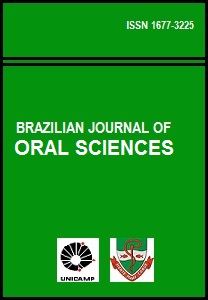Abstract
The aim of this article was to compare complete dentures made by two techniques: with and without face-bow. Five edentulous subjects were selected and each one received two pairs of complete dentures. Dentures were made from duplicated casts and each one followed different techniques. One technique used face-bow and artificial teeth. Teeth were set using individualized wax ridges as guides. The other technique used an articulator, which avoids face-bow and teeth were set by the cast-analysis method. The number of occlusal contacts in centric relation and excursive movements were registered, as well as the opinion of patients regarding denture bearing during oral functions. Both groups presented balanced dentures, but the technique that avoids face-bow presented better results regarding to esthetics, comfort and stability. Balanced occlusion was provided even without face-bow and could be an alternative to obtain adequate complete dentures.References
Landa JS. Biologic significance of occlusion and balanced articulation in complete denture service. J Am Dent Assoc 1962; 65: 489-94.
Ruffino AR. Improved occlusion anatomy of acrylic resin denture teeth. J Prosthet Dent 1984; 52: 300-2.
Dubojska AM, White GE, Pasiek S. The importance of occlusion balance in the control of complete dentures. Quintessence Int 1998; 29:389-94.
Pröchel PA, Maul T, Morneburg T. Predicted incidence of excursive occlusal errors in common modes of articulator adjustment. Int J Prosthod 2000; 13: 303-10.
Barnett FC. Articulator mounting and adjustments. Aust Orthod J 1984; 8: 128-30.
Paiva HJ, Gondim NFR. Oclusão Integração clínico-protética. In: Paiva HJ. Oclusão: noções e conceitos básicos. São Paulo: Santos; 1997. p.155-94.
Akerly WB. Recording jaw relationships in edentulous patients. Dent Clin North Am 1996; 40: 53-70.
Adrien P, Schouver J. Methods for minimizing the errors in mandibular model mounting on an articulator. J Oral Rehabil 1997; 24: 929-35.
Scannapieco FA, Stewart EM, Mylotte JM. Colonization of dental plaque by respiratory pathogens in medical intensive care patients. Crit Care Med 1992; 20: 740-5.
Shay K. Dental management considerations for institutionalized geriatric patients. J Prosthet Dent 1994; 72: 510-6.
Carlsson GE. Biological and clinical considerations in making jaw relation records. In: Zarb GA, Bolender CL, Carlsson GE. Boucher’s prosthodontic treatment for edentulous patients. Philadelphia: Mosby; 1997. p.197-219.
Shodadai SP, Türp JC, Gerds T, Strub JR. Is there a benefit of using na arbitrary facebow for the fabrication of a stabilization appliance? Int J Prosthod 2001; 14: 517-22.
Anusavice KJ. Denture base resins. In: Anusavice KJ. Philip’s science of dental materials. Philadelphia: WBSaunders; 1996. p.237-71.
Hüe O, Mariani P. O Sistema de Prótese Biofuncional (BPS) - Um novo método para a confecção de próteses totais. Dental spectrum 1999; 5:367-378.
Ohguri T, Kawano F, Tchikawa T, Matsumoto N. Influence of occlusal scheme on the pressure distribution under a complete denture. Int J Prosthod 1999; 12: 353-8.
The Brazilian Journal of Oral Sciences uses the Creative Commons license (CC), thus preserving the integrity of the articles in an open access environment.

